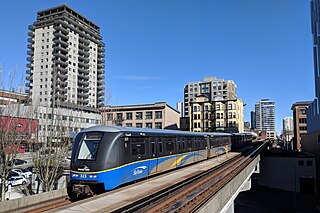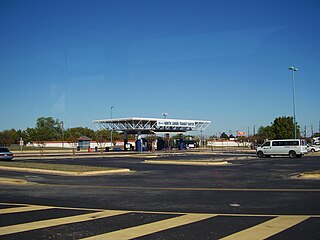
The Metro Blue Line is a 12-mile (19.3 km) light rail line in Hennepin County, Minnesota, that is part of the Metro network. It travels from downtown Minneapolis to Minneapolis–Saint Paul International Airport and the southern suburb of Bloomington. Formerly the Hiawatha Line prior to May 2013, the line was originally named after the Milwaukee Road's Hiawatha passenger train and Hiawatha Avenue, reusing infrastructure from the former and running parallel to the latter for a portion of the route. The line opened June 26, 2004, and was the first light rail service in Minnesota. An extension, Bottineau LRT, is planned to open in 2028.

The Downtown Seattle Transit Tunnel (DSTT), also referred to as the Metro Bus Tunnel, is a 1.3-mile-long (2.1 km) pair of public transit tunnels in Seattle, Washington, United States. The double-track tunnel and its four stations serve Link light rail trains on the 1 Line as it travels through Downtown Seattle. It runs west under Pine Street from 9th Avenue to 3rd Avenue, and south under 3rd Avenue to South Jackson Street. 1 Line trains continue north from the tunnel to Northgate station and south through the Rainier Valley past Seattle–Tacoma International Airport to Angle Lake station as part of Sound Transit's light rail network.
The Capital Metropolitan Transportation Authority, officially stylized as CapMetro, is a public transportation provider located in Austin, Texas. It operates bus, paratransit services and a commuter rail system known as CapMetro Rail in Austin and several suburbs in Travis and Williamson counties. In 2022, the system had a ridership of 21,145,300, or about 80,900 per weekday as of the third quarter of 2023.

Capital MetroRail is a hybrid rail system that serves the Greater Austin area in Texas and is owned by Capital Metro, Austin's primary public transportation provider. The Red Line is Capital Metro's first and currently only rail line, and connects Downtown Austin with Austin's northwestern suburbs. The line operates on 32 miles (51 km) of existing freight tracks, and serves nine stations. After a series of delays, Capital MetroRail was inaugurated in March 2010. Capital Metro added Friday evening and Saturday afternoon and evening regularly scheduled service on March 23, 2012. In 2022, the line had a ridership of 466,800, or about 1,500 per weekday as of the third quarter of 2023.

The Regional Connector Transit Project constructed a 1.9-mile (3.1 km) light rail tunnel for the Los Angeles Metro Rail system in Downtown Los Angeles. It connected the A and E lines with the former L Line. The A and E lines previously both terminated at 7th Street/Metro Center station, coming from Long Beach and Santa Monica, respectively, while the L Line ran through Little Tokyo/Arts District to either Azusa or East Los Angeles. Now the A and E lines continue together through new stations at Grand Avenue Arts/Bunker Hill, Historic Broadway, and Little Tokyo/Arts District. From there, they diverge on the former L Line toward Azusa and East Los Angeles, respectively. The project provides a one-seat ride into the core of Downtown for passengers on those lines who previously needed to transfer, thus reducing or altogether eliminating many transfers of passengers traveling across the region via Downtown Los Angeles.

The K Line is a 5.9-mile (9.5 km) light rail line running north–south between the Jefferson Park and Westchester neighborhoods of Los Angeles, California, passing through various South Los Angeles neighborhoods and the city of Inglewood. It is one of six lines in the Los Angeles Metro Rail system operated by the Los Angeles County Metropolitan Transportation Authority (LACMTA). It opened on October 7, 2022, making it the system's newest line.

Westlake station is a light rail station that is part of the Downtown Seattle Transit Tunnel in Seattle, Washington, United States. The station is located under Pine Street between 3rd and 6th avenues in Downtown Seattle, near Westlake Center and Westlake Park. It is served by the 1 Line, part of Sound Transit's Link light rail system, and also connected above ground by buses at several stops, the South Lake Union Streetcar, and the Seattle Center Monorail.

Little Tokyo/Arts District station is an underground light rail station on the Los Angeles Metro Rail system which replaced an at-grade station with the same name. The at-grade station was located on the east side of Alameda Street, between 1st Street and Temple Street, on the edge of Little Tokyo and the Arts District in Downtown Los Angeles. The at-grade station opened in 2009 as part of the Gold Line Eastside Extension, and was served by the L Line. The at-grade station closed in October 2020, and the new underground station on the south side of 1st Street between Central Avenue and Alameda Street opened on June 16, 2023.

Capital MetroRapid is a bus rapid transit service in Austin, Texas, owned and operated by the Capital Metropolitan Transportation Authority. It currently consists of two routes which run north-south served by stations designed by McKinney York Architects.

The O-Train is a light rail rapid transit system in Ottawa, Ontario, Canada, operated by OC Transpo. The O-Train system has two lines, the electrically-operated Confederation Line and the diesel-operated Trillium Line. Since May 2020, Stage 2 construction has temporarily shut down Line 2, with replacement bus service being offered at all stations. When Line 2 reopens in 2024, it will extend southward to Limebank station and incorporate five newly constructed stations, as well as an additional line linking Line 2 to Ottawa International Airport which will replace the current bus service from route 97. By 2026, expansions along Line 1 and the construction of Line 3 stations in the west end are expected to be complete, bringing the system's length to 64.5 km (40.1 mi), four lines and 41 stations. The O-Train network is fully grade separated and does not have any level crossings with roads. As such, it falls within the category of a light metro.
The Southeast Gateway Line, formerly called the West Santa Ana Branch Transit Corridor, is a planned light rail line, mostly following the Pacific Electric's historic West Santa Ana Branch, connecting Downtown Los Angeles to the city of Artesia, along with other cities in southeastern Los Angeles County.
The history of the Los Angeles Metro Rail and Busway system begins in the early 1970s, when the traffic-choked region began planning a rapid transit system. The first dedicated busway opened along I-10 in 1973, and the region's first light rail line, the Blue Line opened in 1990. Today the system includes over 160 miles (260 km) of heavy rail, light rail, and bus rapid transit lines, with multiple new lines under construction as of 2019.
The Blue Line is a planned light rail line for connecting Austin–Bergstrom International Airport with downtown Austin, Texas. It is still in the planning stages as a part of Capital Metro's Project Connect. It is estimated to begin revenue service as early as 2029.

Urban rail transit in Canada encompasses a broad range of rail mass transit systems, including commuter rail, rapid transit, light rail, and streetcar systems.

Project Connect is a transit expansion program by the Capital Metropolitan Transportation Authority in Austin, Texas, U.S. The program was approved by voters on November 3, 2020, in a local election concurrent with the 2020 presidential election.

D2 Subway is a proposed 2.4 mi (3.9 km) expansion of the DART Light Rail system in metropolitan Dallas, Texas, in the United States. The subway would run from the existing Victory station, tunneling underground through the city centre of downtown Dallas, and connect to the existing tunnel under Cityplace. Four new stations would be built along the new alignment.
The Gold Line is a proposed transitway for connecting North Central Austin and the Downtown's Eastside to South Austin. It is in the planning stages as a part of Capital Metro's Project Connect. According to the plan, the line will be initially be operated as a bus rapid transit line prior to future conversion to light rail. It is estimated to open in 2024.
The Green Line is a proposed commuter rail line for connecting the Northeast Austin area of Colony Park with the downtown Austin, Texas area in the United States. It is still in the planning stages as a part of Capital Metro's Project Connect.
The Orange Line is a proposed north-south light rail line that will serve the central spine of Austin from North Lamar to Stassney Lane. It is in the planning stages as a part of Capital Metro's Project Connect. It is estimated to begin revenue service as early as 2029.

North Lamar Transit Center is a Capital Metropolitan Transportation Authority bus station in Austin, Texas. It is located on North Lamar Boulevard on the north side of U.S. Route 183. The station features a park and ride lot and is served by several local bus routes as well as MetroRapid Route 801. As part of Project Connect, a Capital MetroRail light rail station is planned to be built at the facility; it is planned to be the northern terminus of the system.












